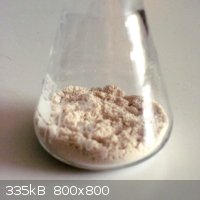CookieNZ
Harmless

Posts: 2
Registered: 22-12-2007
Member Is Offline
Mood: No Mood
|
|
Strontium Carbonate--->Strontium Nitrate problems
I have recently tried the following:
Strontium Carbonate+Nitric acid----->Carbon dioxide+Strontium Nitrate
Now i reacted them together all was good and the Carbon Dioxide was released from he reaction. The problem was when i started heating the solution and
it wouldn't evaporate past a certain point 90ml mark on the conical flask. I was heating well over 150 degrees and the solution did nothing more.
How can i separate this liquid of it and what is it?! It smelt of strong nitric acid but surely it ( the nitric acid) would have evaporated with the
water after 2-3hrs! Or it formed an azeotrope ? if it did how would i get rid of this, react with more strontium carbonate?
Thanks for any help guys
|
|
|
Xenoid
National Hazard
   
Posts: 775
Registered: 14-6-2007
Location: Springs Junction, New Zealand
Member Is Offline
Mood: Comfortably Numb
|
|
Hi Cookie,
Did you use stoichiometric quantities of the reagents.
SrCO3 + 2HNO3 ---> Sr(NO3)2 + CO2 + H2O
147.6g + 2x 63.0g ---> 211.6 g Sr(NO3)2
68% Nitric Acid contains 68g HNO3 per 100 mls
Thus you would need 185.3 mls of 68% Nitric Acid to react with 147.6g of SrCO3 or parts there of. Did you use too much Nitric acid!
|
|
|
YT2095
International Hazard
    
Posts: 1091
Registered: 31-5-2003
Location: Just left of Europe and down a bit.
Member Is Offline
Mood: within Nominal Parameters
|
|
I tend to find even with 38% nitric that when adding the carbonate there comes a point of saturation and the Sr nitrate falls out of soln as crystals
and needs the addition of water to keep it all in a liquid state (I can only Imagine what working with 68% would be like!) keep adding the carbonate
until there`s no more fizzing and then add a little extra.
filter it off leaving your clear Sr nitrate.
I then just let it evaporate to crystals.
it`s a nice and simple way to do such reactions if you don`t have scales or PH papers/indicator.
\"In a world full of wonders mankind has managed to invent boredom\" - Death
Twinkies don\'t have a shelf life. They have a half-life! -Caine (a friend of mine)
|
|
|
CookieNZ
Harmless

Posts: 2
Registered: 22-12-2007
Member Is Offline
Mood: No Mood
|
|
Thank you both for the speedy replies!
I was not using stoichiometric quantities of either but thank you Xenoid for the explanation. Yes the crystals do keep settling to the bottom of the
flask which is annoying. So i should add more water to the reaction to get them to dissolve? Next time i will use stoichiometric quantities so as to
avoid the same incident :-)
The acid im working with is also 68% by the way.
|
|
|
tetrahedron
Hazard to Others
  
Posts: 210
Registered: 28-9-2012
Member Is Offline
Mood: No Mood
|
|
strontium nitrate from strontium carbonate and ammonium nitrate
the metathesis is driven by the evolution of ammonia and carbon dioxide:
SrCO3 (s) + 2 NH4NO3 (aq) --(boiling H2O)-> Sr(NO3)2 (aq) + H2O + 2
NH3 (g) + CO2 (g)
the nearly insoluble carbonate dissolves enough to provide (bi)carbonate ions that bind ammonium to form the thermally unstable ammonium
(bi)carbonate, which decomposes at boiling temperature and leaves.
15.53g strontium carbonate (pottery grade) was used without purification. it obviously contained some sulfide, as a foul smell was evolved at the
beginning of the procedure (H2S is also a weak acid and behaves like carbonic acid in the equation above).
30.39g ammonium nitrate (recrystallized from fertilizer, damp and probably still containing some organic impurities, see my other post) were also added, along with enough tap water (unfortunately this introduces some foreign cations; use distilled water if you prefer)
to fill the 250mL RBF about halfway.
the suspension was heated on a mantle with some cupronickel coins as boiling stones (these became dark due to the ammonium+sulfide+nitrate induced
patina effect). the smell of ammonia was immediately noticeable (collect the fumes in a wash bottle to remove it, or do this in a fume hood or
outside).
after several hours and several water additions later, the ammonia smell subsided and the boiling was stopped. the suspension was filtered, the cake
washed twice with little water. filtrate and wash water were mixed, this gave a very pale liquid which was boiled down until 'thick'. upon cooling, a
lot of the solute crystallized. this was thought to be mostly unreacted ammonium nitrate, as this compound has a steeper solubility curve than the
strontium analog.
the supernatant was decanted and boiled to dryness in a stainless steel pot on a propane stove. soon the copious evolution of white smoke started,
while the residue bubbled tamely. this is mostly nitrous oxide from the thermal decomposition of ammonium nitrate, not dangerous but it tends to
linger and could alert the unsuspecting witness. OTOH strontium nitrate is stable at least up to its melting point (570°C) and should remain mostly
intact. the solid residue was broken up with a spatula and powdered until the evolution of smoke stopped. result:

the last step can be avoided by taking advantage of the differential solubility of the nitrates in acetone (or ethanol): NH4NO3
>> Sr(NO3)2.
a small sample dissolved in water completely. the color is probably due to the metals in the stainless steel pot. a pyrex dish would be preferable.
edit. today while searching for lithium nitrate i ran into this 10-year-old post discussing this reaction in general terms, starting from any carbonate. indeed, before the strontium attempt i ran the same
reaction with manganese, but unfortunately the manganese nitrate wasn't easy to separate from the unreacted ammonium nitrate. OTOH lithium seems to
work much more efficiently.
[Edited on 14-11-2012 by tetrahedron]
|
|
|